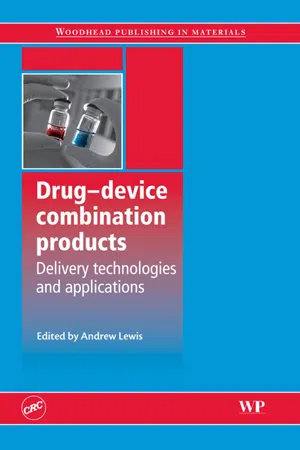
- 560 pages
- English
- ePUB (mobile friendly)
- Available on iOS & Android
About This Book
Drug delivery systems represent a vast area of research and development within biomaterials and medicine and the demand for sophisticated drug delivery devices continues to drive novel product development. Advanced drug delivery devices can offer significant advantages over conventional drugs and devices alone, such as increased efficiency, improved performance and convenience. The purpose of this book is to illustrate how effective drug delivery can be achieved by means other than tablets. The book will provide a thorough analysis of the fundamentals, applications and new technologies of drug-device combination products for use throughout the human body.Part one provides readers with an introduction and background to the field. Chapters in Part two discuss areas of application such as catheter based products, drug eluting stents and beads and anti-biotic loaded cements. Part three covers the development of drug device combination products with chapters on such topics as pre-clinical testing, sterilisation, patent issues and regulation of drug device combination products.With its distinguished editor and team of international contributors, Drug-device combination products: delivery technologies and applications is an invaluable reference for product development specialists, materials scientists and engineers in the biomedical industry and academia as well as those concerned with drug delivery.
- Illustrates how effective drug delivery can be achieved by means other than tablets providing readers with a comprehensive introduction and background to the field
- Provides a thorough analysis of the fundamentals, applications and new technologies of drug device combination products
- Discusses areas of application such as catheter based products and reviews the development of drug device combination products including pre-clinical testing and sterilisation
Frequently asked questions
Information
Drug–device combination products
Abstract
1.1 Introduction
1.2 Rationale for drug–device combination applications
1.3 Drug-enhanced device products
1.3.1 Drug eluting stents
Table of contents
- Cover image
- Title page
- Table of Contents
- Related titles
- Copyright
- Contributor contact details
- Preface
- Part I: Overview
- Part II: Areas of application
- Part III: Development of drug–device combination products
- Index